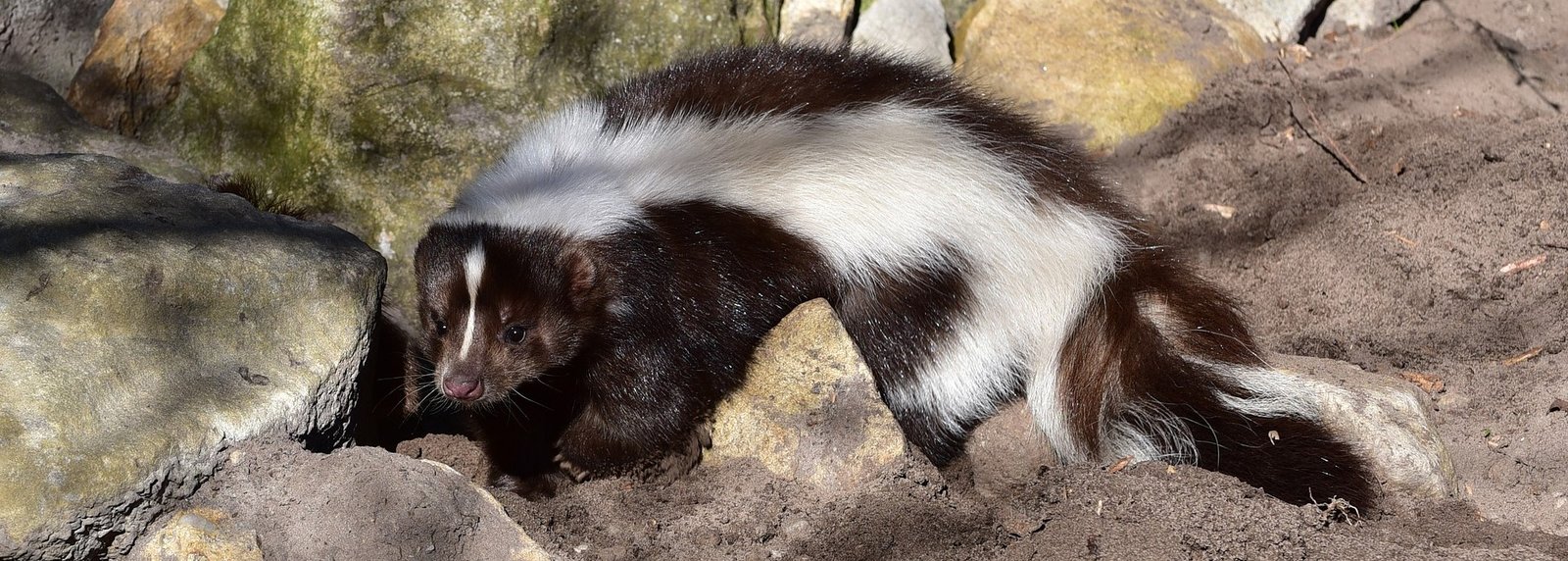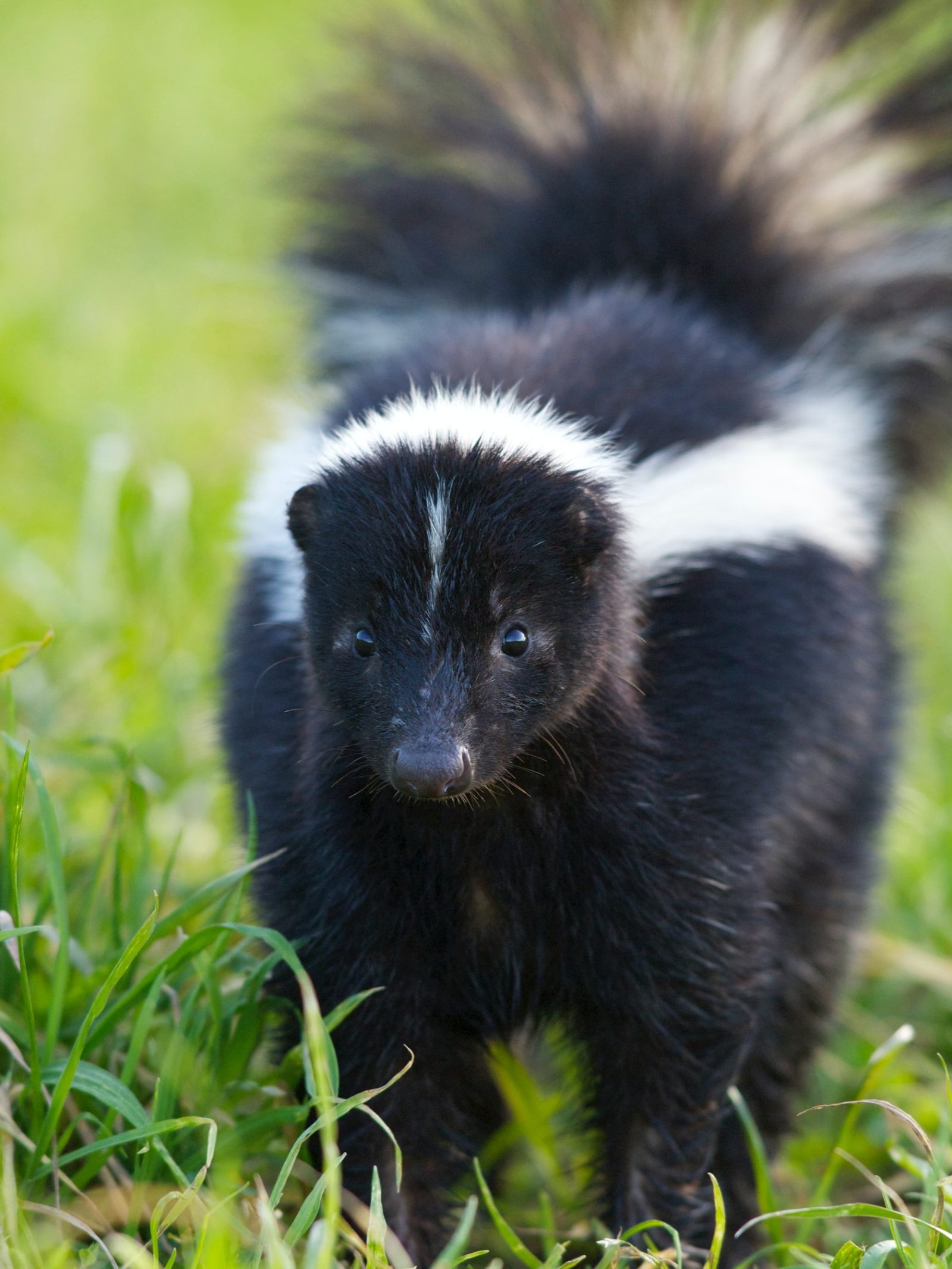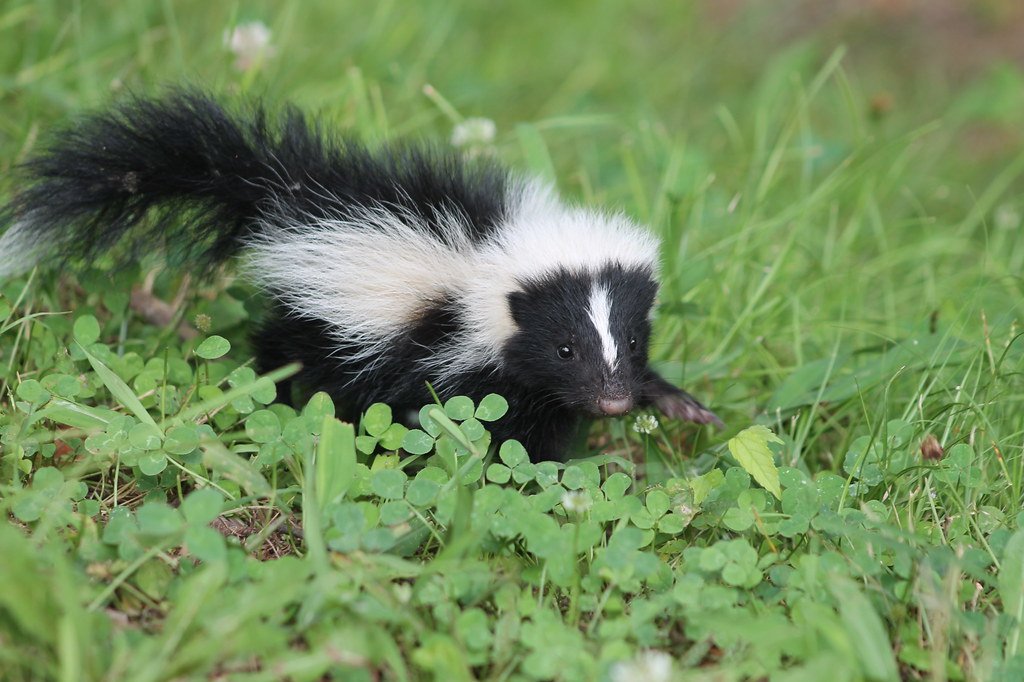Skunk Removal & Damage Repair

People should avoid attempting skunk removal on their own and treat an encounter with caution because of the skunk’s natural chemical weapons. If a skunk has created a nest on your property, contact a skunk control professional to safely and humanely relocate the animal.
Skunks’ black and white coloration is well-known, as is their ability to spray a stinky secretion from scent sacs in their hindquarters. A scent gland is located on each side of the anus and is surrounded by muscles. Skunks spray a yellowish, nauseating musk when they are startled. The secretion causes temporary blindness as well as a foul, lingering odor.
What Do Skunks Look Like?
 Striped skunks are the most common skunk species in the United States (spotted skunks are present but less common). The critters weigh 6 to 14 pounds and are similar in size to domestic cats. Their snouts are pointed, and their heads are small and triangular, with a white stripe across the nose and forehead.
Striped skunks are the most common skunk species in the United States (spotted skunks are present but less common). The critters weigh 6 to 14 pounds and are similar in size to domestic cats. Their snouts are pointed, and their heads are small and triangular, with a white stripe across the nose and forehead.
This skunk’s coats are usually black with white stripes that run down the nape of their neck and split into two white stripes on the back. These white stripes are as individual as human fingerprints, with each one being slightly different.
Skunks have wide, long, bushy tails that can be completely black or have varying amounts of white. They appear to waddle when walking and are poor climbers due to their short legs. However, they have strong forefeet and long nails, making them excellent diggers. 1Go To Source mass.gov -“Learn About Skunks”
Where Are Skunks Found?
The skunk can be found in a variety of environments but prefers open spaces. As abandoned fields and pastures become forested, its population usually decreases. On the other hand, Skunks benefit from roadside and lawn mowing and any other maintenance practice that prevents the development of a forest canopy. Skunks thrive in residential areas with both lawns and large, shade-producing trees. Protected spaces near residential buildings such as crawlspaces, decks, and sheds provide everything a skunk needs to survive. 2Go To Source dec.ny.gov -“Striped Skunk”
Distribution Of Skunks
Except in the Southwest, the striped skunk can be found throughout the lower 48 states. These creatures are highly adaptable and will survive in most climates.
Throughout the majority of the year, males and females share overlapping home ranges of 0.77 to 1.54 square miles for females and up to 7.7 square miles for males.
Diet Of Skunks
The skunk is an omnivore, which means it eats both plant and animal matter. Insects (especially grubs), small mammals, earthworms, snails, grains, nuts, fruits, reptiles, vegetation, amphibians, birds, eggs, carrion, and garbage are all part of the skunk’s diet. 3Go To Source dnr.maryland.gov -“Striped Skunk (Mephitis mephitis)”
Property Damage Caused By Skunks
 Though these cute little creatures appear harmless, they are responsible for wreaking havoc on a property by digging up lawns to make dens, destroying the vegetation. Not only that, but they might try to get into the attic and damage the wiring. If a skunk family has taken up residence in your yard or attic, do not ignore their presence and hire an animal control professional to evict them.
Though these cute little creatures appear harmless, they are responsible for wreaking havoc on a property by digging up lawns to make dens, destroying the vegetation. Not only that, but they might try to get into the attic and damage the wiring. If a skunk family has taken up residence in your yard or attic, do not ignore their presence and hire an animal control professional to evict them.
Burrowing & Digging Holes
Skunks can dig shallow burrows anywhere in the soil with their sharp claws and strong front legs. Check for skunk activity if you notice any holes or signs of digging. Their digging habit can cause costly structural damage and detract from a yard’s aesthetic appeal.
Broken Vent Screens
Skunks may try a variety of methods to gain access to your property. This includes, among other things, chewing the vent screens, damaging the chimney mesh, and tearing the attic insulation and wiring. Their teeth and claws are powerful enough to rip through almost any material, including plastic and metal.
Intoxicating Odor
Skunks use their anal glands to produce a strange odor that scares away intruders. When you or your pet approaches them, they are known to release an odor. It’s their fight-or-flight response to a danger or threat. Furthermore, they may contaminate a property with odorous feces and urine droppings.
Signs Of A Skunk Infestation
- Tracks
- Unpleasant Odors
- Lawn & Garden Damage
- Physical Sightings
Skunk Exclusion
 Like many other vertebrate pests, skunk problems beneath buildings are best solved by screening or blocking them out. For all entrances or openings in the foundations of homes and outbuildings, such exclusion is required. To keep skunks out, close off spaces beneath porches, stairs, and mobile homes.
Like many other vertebrate pests, skunk problems beneath buildings are best solved by screening or blocking them out. For all entrances or openings in the foundations of homes and outbuildings, such exclusion is required. To keep skunks out, close off spaces beneath porches, stairs, and mobile homes.
Skunks are deterred from excavating or reentering beneath porches, shallow decks, and slab foundations by buried wire fencing. A skirting or band of mesh hardware cloth must be fastened tightly to the porch, deck, or foundation’s above-ground structure. The lower portion of the fence should be below ground level. Skunks and other burrowing animals (moles) will be discouraged from digging beneath the barrier. If the skunks have already entered your home, wildlife professionals must humanely relocate skunks far away from the home.
Humane Skunk Trapping & Removal
A thriving native skunk population can be found throughout the United States. However, when skunks invade your property, it can be aggravating. That is Animals Happen here to help will all skunk-related issues and remove skunks from your property.
All of your skunk removal and skunk control issues can be handled by Animals Happen’s pre-qualified wildlife animal control specialists. An experienced animal control expert can locate your skunk problem and recommend an appropriate solution for your situation. If you have skunks on your property, call us right away at 833-633-1120.
Sources:
- Commonwealth of Massachusetts. “Learn about Skunks.” Mass.Gov, Commonwealth of Massachusetts, www.mass.gov/service-details/learn-about-skunks. Accessed 23 June 2021.
- “Striped Skunk – NYS Dept. of Environmental Conservation.” New York State, New York State, www.dec.ny.gov/animals/9353.html. Accessed 23 June 2021.
- “Striped Skunk.” Drn.Maryland.Gov, State Of Maryland, dnr.maryland.gov/wildlife/Pages/plants_wildlife/Striped_Skunk.aspx. Accessed 23 June 2021.
